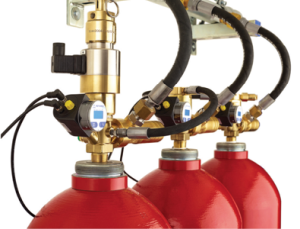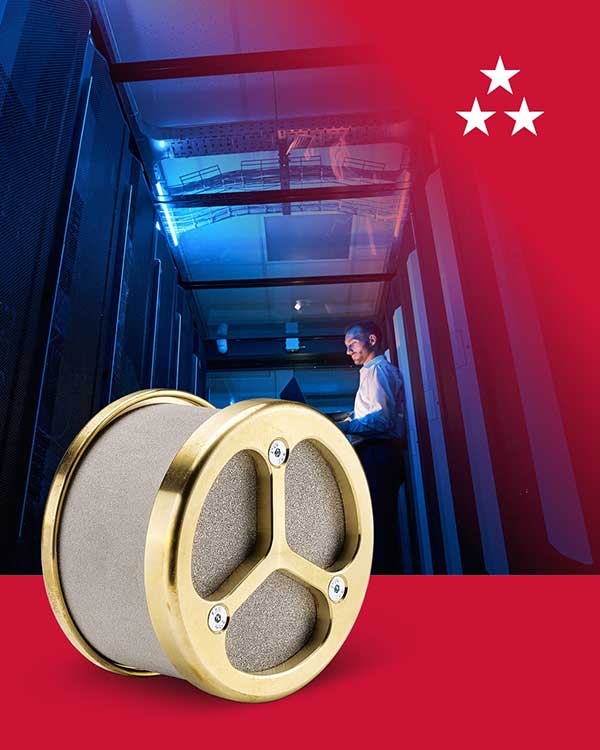Your Inert Gas Fixed Installation Fire System May Be About to Fail

Here, I’ll describe one common way an inert gas fire detection and fire extinguishing system can fail – and how you can be sure it won’t happen to you.
To ensure a fire can be extinguished in a designated area, engineers calculate how much inert gas needs to be released to displace the oxygen level below 15% concentration and extinguish the fire. The number of cylinders is precisely calculated to supply the required volume of gas.
So what happens if a cylinder starts to leak? Although rare, this can happen from time-to-time in any installation, but especially in applications subject to vibration, motion, shock or wide temperature variations. Should leaks cause the volume of gas in the cylinders be lower than the design concentration level needed to extinguish a fire, the system will fail. To detect a potential leak, alarmed pressure gauges are commonly used which operate on the principle that a drop in pressure corresponds to a loss of gas in the cylinder. This traditional pressure gauge sends an alert when the pressure drops below a designated level.
And that’s where the potential for system failure occurs. Pressure within a cylinder fluctuates with changes in temperature. This means the pressure gauge cannot accurately measure cylinder contents as temperatures vary. Let me show you how this can create a serious situation:
The Wind Turbine Example
A wind turbine is protected by an IG system with two 300 bar cylinders. The alarm threshold is set at 270 bar. On a very hot day it is 45º C inside the turbine. There is a leak in an IG cylinder, but the standard pressure gauge does not register a drop below 270 bar. At this point, there is not enough gas remaining to extinguish a fire, but it is not reported. If a fire occurs, the wind turbine can be destroyed.
Conversely, on a very cold day, inside temperature falls below 5º C, a standard pressure gauge would register a drop below 270 bar even though the cylinders are full and not leaking. A false alarm is triggered, provoking an unneeded – and costly – maintenance call.
To solve this problem, we turned to our in-house expert Dr. Thomas Andreas – inventor of the DIMES CO2 system – to develop an IG DIMES system. Over 2 ½ years of development, Dr. Andreas and his team studied the dynamic relationship of pressure and temperature for the 4 main types of inert gas used in fire suppression: nitrogen, argon, IG 55 and IG 541. The evaluated how each inert gas influences cylinder pressure as temperatures vary. Using gas behavior data, they created advanced algorithms to calculate the real gas dynamics at every temperature. This gives you an extremely accurate reading of cylinder contents at all temperatures.
The DIMES IG system is designed for cylinder pressure from 0 to 400 bar. Best of all, it is 99.9% accurate.
Dr. Andreas and his colleagues developed custom sensors, used real gas behavior maps to generate complex algorithms, employed advanced engineering to integrate components, developed software to control the device and created a user-friendly interface. The team even considered traceability, allowing calibration data, cylinder information, specifications and maintenance schedules to be saved within the software and exported to external devices as a PDF.
By simply replacing traditional pressure gauges with the new digital DIMES IG system, you can be more confident that your system is fully pressurized and will not fail at the critical moment. It will be ready at all times, 24/7/365.
Rotarex is uniquely qualified to deliver this advanced DIMES technology thanks to three factors…
- Gas flow expertise
Over 90+ years of experience, we’ve become industry leading experts in gas flow control for all gas major gas types. - In-house electronics laboratory
Through acquisition 10 years ago of a top-level Dutch applied electronics lab, Rotarex has the know-how and infrastructure to develop advanced digital technologies - Dr. Andreas’ knowledge base as inventor of the CO2 DIMES system
From his doctoral thesis through years of work at Rotarex, Dr. Andreas has become the leading expert in digital technologies for fire protection systems.
For more information, please contact me.








